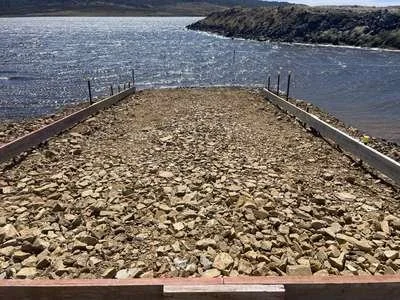The Challenges of a Dry Autumn
We speak frequently of the challenges of Tasmania’s fly fishing. These are things like the fickle wind, the unpredictability of insect hatches, or the propensity of yesterday’s successful fly to become today’s failing fly.
Unfortunately this year we’ve had the addition of difficult water levels enter the mix along with an unfortunate proliferation on cormorants on many of our inland waterways. With work underway to establish Tasmania’s role in the “Battery of the Nation” agenda established by the government, we have also seen major disruptions to the water levels in the Bronte chain of lakes, as ageing infrastructure is improved for the sake of bigger water flows for greater energy production.
And recently we have seen Little Pine levels dropped to enable the construction of a new boat ramp.
Foundation of the new Little Pine Boat Ramp
Normally these would not be felt as strongly as they have this year, but the Bronte chain of lakes and Little Pine Lagoon have been critical destinations this season due to challenges elsewhere. In fact they have fished really well, providing good fly fishing success to visiting anglers at a time when other traditionally reliable waters have been less reliable.
Sadly, while Arthurs Lake remains a viable wet fly fishery, the impact of the Basslink cable failure in 2015 is still having repercussions on Arthurs. As a result of the cable’s failure at a time when Tasmania’s water levels were low, water was drawn down to unprecedented levels on Arthurs with devastating effects on weed beds, insects and spawning. Each year we wait to see a recovery, and each year we have been disappointed. This year has been no exception.
To add to the fishing limitations, Woods Lake has seen an algal bloom which has impacted on water quality and the fly fishing there as well.
It’s all a strong reminder of how precious and fragile our fly fishing environment is, and how much we should value and protect it. With water levels decreasing and temperatures increasing, we all need to do what we can to protect our fishery. One important factor that our US counterparts have shared with us is the need to consider the extent to which we might be distressing our fish. As water temperatures rise, the importance of minimising the fight becomes important. Slightly heavier leaders and tippets should mean we can land fish more quickly and release them more quickly.
Thankfully, there are still fish to be caught, and good fish at that. As mentioned, Bronte Lagoon and Little Pine have offered some very good fishing. And for clients of The Highland Fly, Herne Lodge has been a saviour, with plenty of wild brown trout happily taking a broad range of dry flies.
And so, as we approach the end of the season, remember there are still good fishing options on offer, but the importance of getting good guidance and support from a local has become more important. Get in touch now to grab some late season days, or start planning your 2024-25 visit now.



